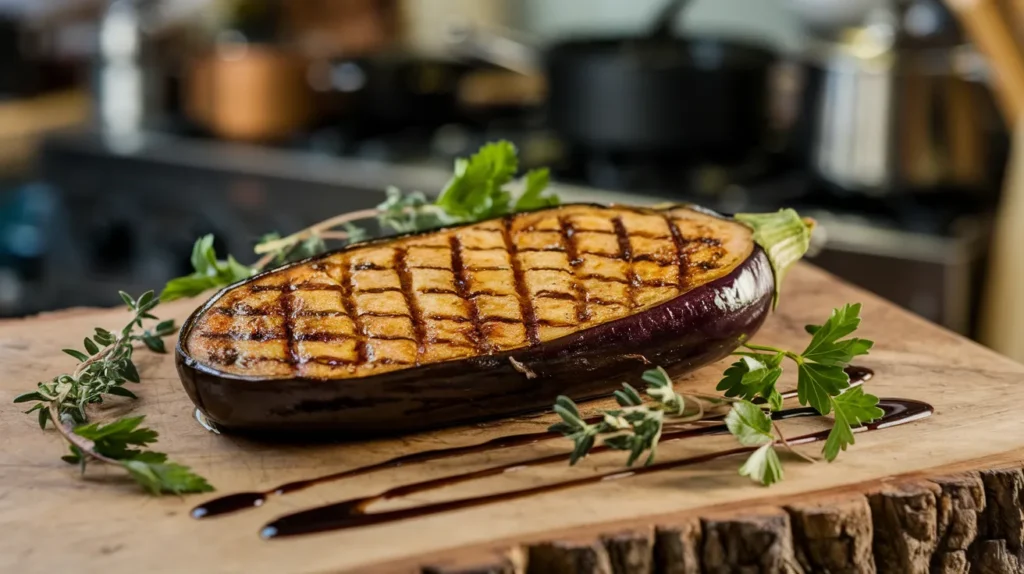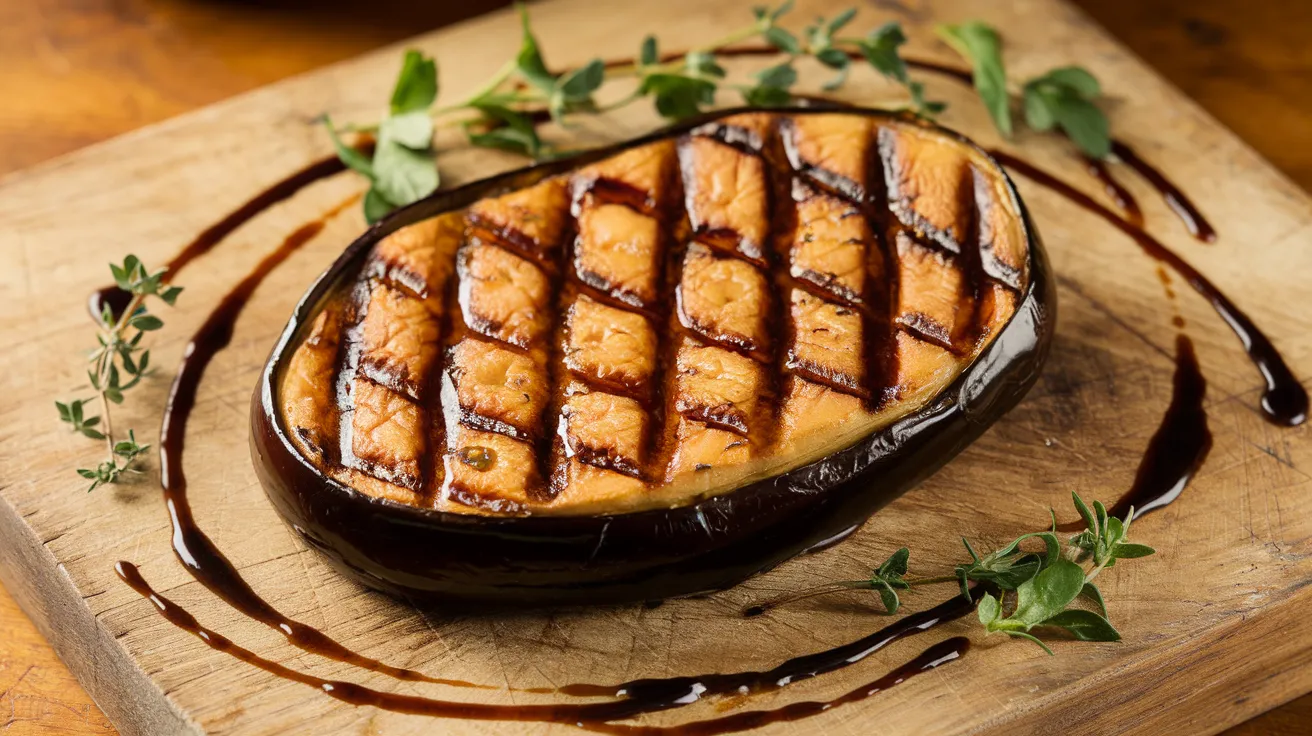Transform ordinary eggplant into a satisfying, steak-like centerpiece that will wow even the most devoted carnivores. This eggplant steak recipe delivers incredible texture and bold flavors through simple marination and perfect grilling techniques, creating a hearty meal that proves vegetables can be just as satisfying as meat.
SERVES: 4 | PREP: 20 MIN | COOK: 15 MIN | TOTAL: 35 MIN
Ingredients
Main Components
| Ingredient | Amount |
|---|---|
| Large eggplants | 2 medium (about 2 lbs total) |
| Kosher salt | 2 tablespoons |
| Extra virgin olive oil | 1/4 cup |
| Balsamic vinegar | 3 tablespoons |
| Fresh garlic, minced | 4 cloves |
| Fresh thyme leaves | 2 tablespoons |
| Smoked paprika | 1 teaspoon |
| Black pepper, freshly ground | 1/2 teaspoon |
Finishing Touch
| Ingredient | Amount |
|---|---|
| Fresh parsley, chopped | 1/4 cup |
| Lemon juice | 2 tablespoons |
| Flaky sea salt | To taste |
Step-by-Step Instructions
Phase 1: Preparation and Salt Treatment (10 minutes)
Step 1: Slice each eggplant lengthwise into 4 thick steaks, about 3/4-inch thick each. You want substantial pieces that won’t fall apart during cooking. Save the rounded end pieces for another use or dice them for a side dish.
Step 2: Generously salt both sides of each eggplant steak with kosher salt. This crucial step draws out bitter compounds and excess moisture. Lay the salted steaks on a large baking sheet lined with paper towels.
Step 3: Let the eggplant steaks sit for 10 minutes. You’ll notice moisture beading on the surface – this is exactly what we want. The salt is working to concentrate flavors and improve texture.
Phase 2: Marinade Preparation (5 minutes)
Step 4: While the eggplant rests, whisk together olive oil, balsamic vinegar, minced garlic, fresh thyme, smoked paprika, and black pepper in a shallow dish. This marinade will penetrate the eggplant and add incredible depth.
Step 5: Taste your marinade – it should be bold and well-balanced. The balsamic provides sweetness and acidity, while the garlic and thyme add aromatic complexity. Adjust seasoning if needed.
Phase 3: Final Prep and Marination (5 minutes)
Step 6: Pat the eggplant steaks completely dry with clean paper towels. Remove as much surface salt and moisture as possible – this ensures proper browning and prevents steaming.
Step 7: Brush both sides of each eggplant steak generously with the prepared marinade. Make sure to coat every surface, paying special attention to the cut edges where flavors can penetrate deepest.
Step 8: Let marinated steaks rest for 5 minutes at room temperature. This brief marination allows the flavors to begin penetrating while keeping the eggplant at ideal cooking temperature.
Phase 4: Cooking Process (12 minutes)
Step 9: Heat a large grill pan or cast-iron skillet over medium-high heat. The pan is ready when a drop of water sizzles and evaporates immediately. Don’t use too high heat or the outside will burn before the inside cooks through.
Step 10: Carefully place eggplant steaks in the hot pan, leaving space between each piece. You should hear an immediate sizzle – this creates the beautiful grill marks and caramelization we’re after.
Step 11: Cook for 5-6 minutes without moving the steaks. Resist the urge to peek or flip early – let them develop those gorgeous grill marks and caramelized flavor. The edges should start looking golden and slightly translucent.
Step 12: Flip each steak carefully using a wide spatula. The cooked side should be golden brown with defined grill marks. If it’s pale, cook another minute before flipping.
Step 13: Cook the second side for 4-5 minutes until golden brown and the eggplant feels tender when gently pressed with the spatula. The internal temperature should reach 170°F for perfect doneness.
Phase 5: Finishing and Serving (3 minutes)
Step 14: Remove eggplant steaks from heat and immediately drizzle with fresh lemon juice. The acid brightens all the flavors and adds a fresh contrast to the rich, smoky taste.
Step 15: Sprinkle with chopped fresh parsley and a pinch of flaky sea salt. The herbs add color and freshness, while the salt enhances every other flavor in the dish.
Step 16: Serve immediately while hot. Each eggplant steak should be tender throughout with a beautiful golden exterior and robust, meaty flavor that satisfies completely.
Chef’s Notes
Eggplant Selection: Choose firm, glossy eggplants without soft spots or wrinkles. The stem should be bright green and the skin should spring back when gently pressed. Fresh eggplant makes all the difference in your final eggplant steak.
Salt Timing: Don’t skip the salting step or rush it. This process, called “purging,” removes bitterness and creates better texture. Some recipes suggest 30 minutes, but 10 minutes works perfectly for this thickness.
Heat Management: Medium-high heat is crucial for proper caramelization without burning. If your pan is too hot, the outside chars before the inside cooks. Too cool, and you won’t get those beautiful grill marks.
Doneness Test: Perfectly cooked eggplant should feel tender when pressed but not mushy. It should hold its shape when lifted with a spatula and have a creamy, not spongy, interior texture.
Nutrition Information (Per Serving)
- Calories: 145
- Protein: 3g
- Carbohydrates: 12g
- Fat: 11g
- Fiber: 6g
- Sodium: 590mg
Creative Variations
Mediterranean Style: Top your cooked eggplant steak with crumbled feta, sun-dried tomatoes, and fresh basil. Drizzle with additional olive oil and serve with warm pita bread.
Asian-Inspired: Replace the marinade with soy sauce, sesame oil, ginger, and rice vinegar. Garnish with sesame seeds and sliced scallions. This pairs beautifully with steamed rice.
Caprese Presentation: Layer thick slices of fresh mozzarella and ripe tomatoes on top of each eggplant steak. Finish with fresh basil and a balsamic glaze for an elegant presentation.
Protein-Packed: Serve alongside your favorite eggplant sandwich for a complete vegetarian feast, or pair with this delicious eggplant with green beans for a Mediterranean-inspired meal.
Storage & Reheating
Refrigerator Storage: Store leftover eggplant steaks in an airtight container for up to 3 days. Place parchment paper between layers to prevent sticking.
Freezing: While possible, freezing isn’t recommended as it changes the texture significantly. Fresh eggplant steak is always best.
Reheating: Warm gently in a 350°F oven for 8-10 minutes, or reheat in a skillet over medium heat for 2-3 minutes per side. Avoid microwaving, which makes them soggy.
Make-Ahead: You can salt and marinate the eggplant up to 2 hours ahead. Keep refrigerated and bring to room temperature before cooking for best results.

Troubleshooting Common Problems
Problem 1 – Soggy Texture: This happens when you skip salting or don’t pat the eggplant dry enough. Always salt for the full 10 minutes and thoroughly dry before cooking.
Problem 2 – Bitter Taste: Usually caused by using old eggplant or not salting properly. Choose fresh, firm eggplant and don’t rush the salting process.
Problem 3 – Uneven Cooking: Occurs when steaks are cut too thick or heat is uneven. Keep steaks at 3/4-inch thickness and ensure your pan heats evenly before cooking.
Problem 4 – Sticking to Pan: Make sure your pan is properly preheated and use enough oil in the marinade. A well-seasoned cast-iron or non-stick pan helps prevent sticking.
Problem 5 – No Grill Marks: Your pan isn’t hot enough or you’re moving the eggplant too soon. Let each side cook undisturbed for the full recommended time to develop proper caramelization.
Equipment Essentials
- Large cast-iron skillet or grill pan
- Sharp chef’s knife for clean cuts
- Large baking sheet for salting
- Paper towels for drying
- Wide spatula for flipping
- Mixing bowl for marinade
- Measuring cups and spoons
Shopping List
Produce Section
- 2 medium eggplants (about 2 lbs)
- 1 head fresh garlic
- Fresh thyme bunch
- Fresh parsley bunch
- 1 lemon
Pantry Items
- Kosher salt
- Extra virgin olive oil
- Balsamic vinegar
- Smoked paprika
- Black peppercorns
- Flaky sea salt
Success Secrets
1. Choose eggplants that feel heavy for their size with tight, glossy skin. This indicates freshness and proper moisture content for the best eggplant steak texture.
2. Cut steaks with confident, clean strokes to prevent ragged edges that can burn during cooking. A sharp knife makes all the difference.
3. Don’t overcrowd your pan – cook in batches if necessary. Overcrowding creates steam instead of the searing heat needed for proper caramelization.
4. Let the eggplant do the talking by not over-seasoning. The natural flavor should shine through with just the right amount of enhancement from your marinade.
5. Serve immediately after cooking while the exterior is still crispy and the interior is perfectly tender. This dish is at its absolute best when hot off the grill.




